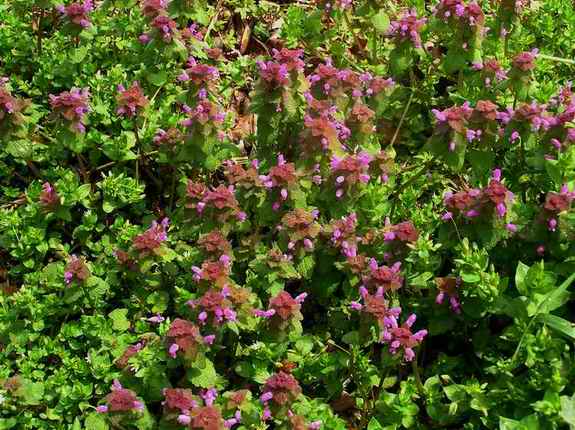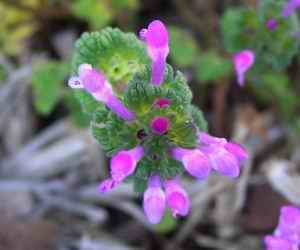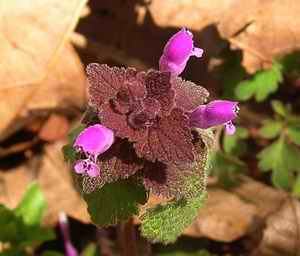|
Return to Hiker's Notebook Home Page
Common Name: Purple Deadnettle, Red nettle, Red deadnettle, Red henbit, Red archangel, Bee nettle - The leaves of the deadnettle are similar to those of the stinging nettle, and it is named accordingly. Since the deadnettle's leaves do not have stinging hairs, the "nettle" is "dead." The upper leaves are purple, or red in color.
Scientific Name: Lamium purpureum - The generic name is from the Greek lamia which means 'devouring monster' in reference to the galeate (helmet) shape of the flower which has the general appearance of open jaws. An alternative etymology is that Lamium is derived from the Greek lamios, meaning 'thread'; the corolla of the flower is "threaded" through the lips. The species name is from purpureus, the Latin word for purple.
Purple Deadnettle is generally considered to be a weed, as it is an undesired and uncultivated plant that crowds out preferred vegetation like turf grasses. It is an adventive plant having been introduced to North America from the Mediterranean basin that is comprised of Europe, western Asia and northern Africa. A winter annual, it propagates by seed and can reach high density concentrations in disturbed areas; an entire fallow field may take on an aesthetic reddish-purple hue in advance of spring ploughing. The pink flowers offset by the purple leaves are quite striking and belie the notion of its consignment to the pejorative weed category.
The Purple Deadnettle is a member of the Mint Family and accordingly has the characteristic four-sided square stem. The paired opposite deltoid-shaped leaves are densely crowded along the stem with each pair offset by 90 degrees from the set immediately above or below. The flowers are arranged in whorls of up to 10 individuals around the axis of the stem. The tubular flowers are divided into distinctive upper and lower lips supported by connivent (with the ends inclined toward each other) purplish -green calyx. The flower blooms in April and lasts for about six weeks, producing four nutlet seeds for propagation. The name Archangel refers to this first appearance; May 8 is dedicated to the Archangel Michel, which was 11 days earlier on April 27 before the Gregorian calendar change of 1582 (which took until 1752 to change in Great Britain).
Henbit (Lamium amplexicaule) is closely related to and confused with t Henbit (Lamium amplexicaule)
Purple Deadnettle (Lamium purpureum)
Purple and Henbit Deadnettle also contradict their classification as nuisance weeds in that they are generally beneficent. They are important nectar and pollen plants for a variety of bees due to their emergence early in the spring; some species are even called Bee nettle to emphasize this association. Deadnettles are used to achieve an aesthetic effect in flower arrangements due to the proportioned structure and bright colors of their leaves and flowers. The young shoots of both plants can be harvested in the spring and used as an additive to salads. The noted Swedish taxonomist Carolus Linnaeus noted that the deadnettles were boiled as a pot herb by the local peasantry. The dried leaves have been used as a poultice to stem hemorrhaging and made into a tea to promote perspiration and discharge from the kidneys in the treatment of chills. Altogether a very good weed. |

 he
Purple Deadnettle, a situation that is exacerbated by the alternative common
name of Henbit Deadnettle. The species name is from the Latin amplexus,
meaning surrounding or encircling, referring to the configuration of the
leaves. And it is the leaves that afford a means of distinguishing the plants;
the green leaves of the Henbit are reniform (kidney-shaped) and sessile
(attached directly to the stem with no petiole or leaf stalk) while those of
the Purple Deadnettle are purple, triangular and are attached to the stem with
a petiole. The name Henbit implies that the seeds are eaten by
chickens.
he
Purple Deadnettle, a situation that is exacerbated by the alternative common
name of Henbit Deadnettle. The species name is from the Latin amplexus,
meaning surrounding or encircling, referring to the configuration of the
leaves. And it is the leaves that afford a means of distinguishing the plants;
the green leaves of the Henbit are reniform (kidney-shaped) and sessile
(attached directly to the stem with no petiole or leaf stalk) while those of
the Purple Deadnettle are purple, triangular and are attached to the stem with
a petiole. The name Henbit implies that the seeds are eaten by
chickens.  Both
Henbit and Purple Deadnettle are mostly tolerated and not extirpated as
invasive pests, unlike a third look-alike that also blooms in April and is a
member of the Mint Family, the ubiquitous
Both
Henbit and Purple Deadnettle are mostly tolerated and not extirpated as
invasive pests, unlike a third look-alike that also blooms in April and is a
member of the Mint Family, the ubiquitous